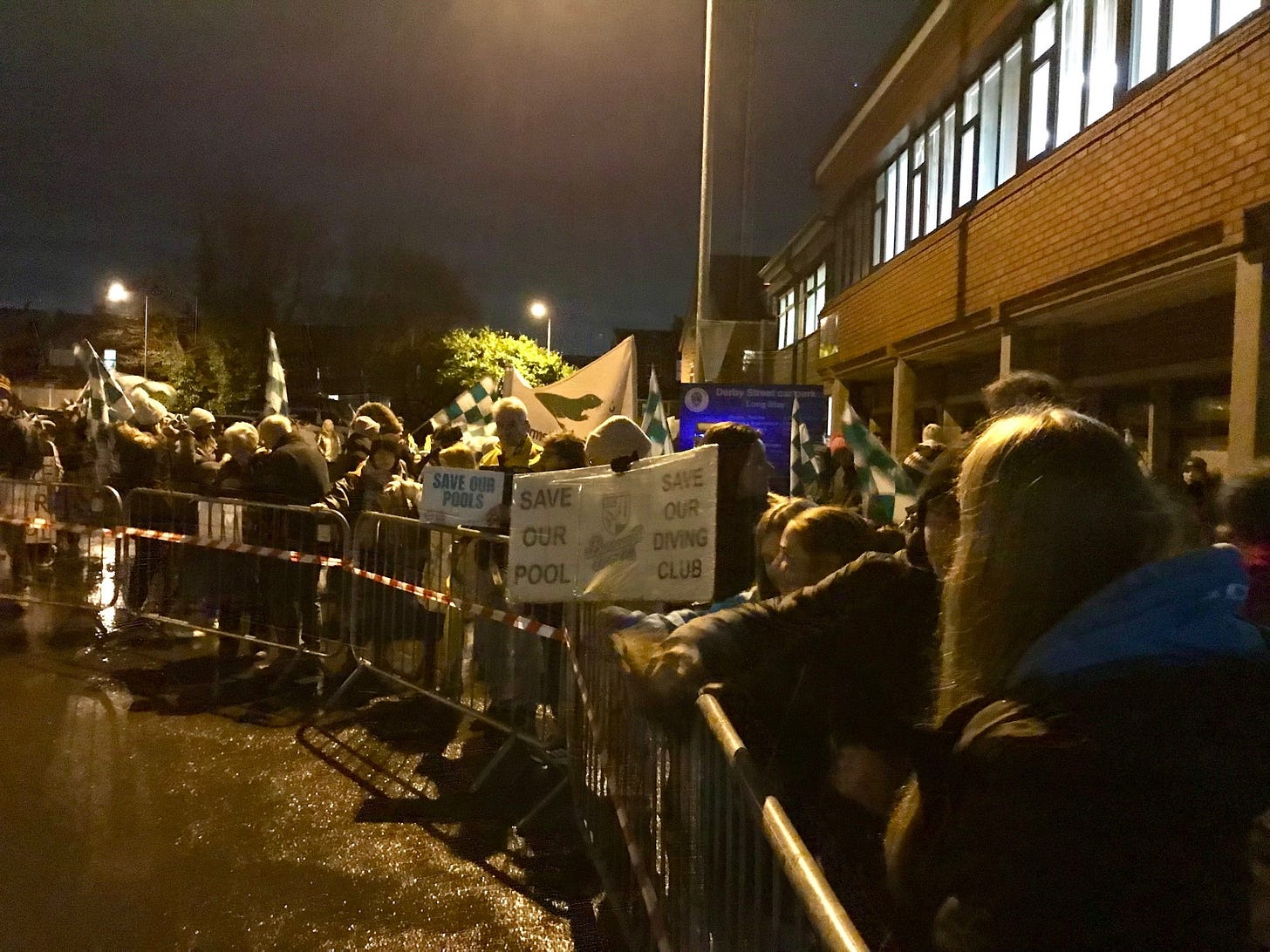15-council-structure depriving Lancashire of funds for local services
PLUS: The latest on the pool saga in West Lancashire
Hello and welcome to The Lancashire Lead.
This week we report on the discussion that is likely to linger over Lancashire for months to come - how local government will look after the compulsory reorganisation.
There are 15 councils in Lancashire - a complicated way of running things by anyone’s metrics - and government plans will see the lot of them scrapped and replaced by either three or four new two-tier authorities.
But Lancashire leaders finding a consensus on how to organise itself under those terms - much like the debate over an elected mayor - feels unlikely.
Elsewhere, we also report on the latest from West Lancashire, where victory for campaigners hoping to see two council-owned swimming pools continue to operate means the council does not yet have balanced books.
Lancashire’s complex council structure taking cash away from local services, says MP
By Paul Faulkner
There is less money available for local services in Lancashire because of the complex way its councils are currently structured.
That was the message from the government minister overseeing a radical revamp of local authorities across the country, which will see Lancashire’s 15 existing councils abolished and replaced with just a handful of new ones covering much larger areas.
Jim McMahon says the aim of the overhaul is to “unlock” the funding he claims is being swallowed up by the present system of having a patchwork of different authorities providing different services.
The change would sweep away Lancashire County Council, the dozen district authorities – in Preston, South Ribble, Chorley, West Lancashire, Fylde, Wyre, Lancaster, Ribble Valley, Burnley, Hyndburn, Rossendale and Pendle – and the two small standalone councils for Blackpool and Blackburn with Darwen.
Speaking during last week’s Convention of the North, the local government minister also stressed that he was prepared to be “flexible” over exactly how many new local authorities Lancashire will get in order to ensure they remain geographically relevant to the people they serve.
His comments came just weeks before the deadline the government has set for the 21 so-called “two-tier” areas of England, like Lancashire, to submit preliminary proposals for a streamlined council set-up in their areas.
Explaining the rationale for what is likely to prove a controversial shake-up, Mr. McMahon said the current arrangements came with a costly “premium”.
“People are paying more for a two-tier system to exist at a time when…for many places, their local neighbourhood services over 14 years – and, by the way, through no fault of local government – have been eroded.
“And so the challenge comes – how do you build those local neighbourhood services that people…value [in] their area and make the quality of life difference? The way to do that is to unlock the money that’s currently held up in that two-tier system – so that we stop paying for overhead costs at the level that we are and we free that money [up at] a local level,” the minister said.
He added that ending the division of responsibilities between the county and district councils and replacing them with single authorities that deliver all services in their area – as is already the case in Blackpool and Blackburn with Darwen – would make matters simpler for locals seeking help from their elected representatives.
“If you’re a resident in Lancashire and you go to your local councillor, how often are you told, ‘Well, actually, I’m not the right councillor, because…I’m your district councillor [and] you need to go to the county’ – and vice versa?” Mr. McMahon asked.
The government has said any new local authorities created as part of the reorganisation process should cover populations of at least 500,000 people. With 1.57m residents, that means Lancashire could accommodate a maximum of three councils under the revamp – but the government’s devolution white paper did say “exceptions” may be made “to ensure new structures make sense for an area”.
That was a point Jim McMahon was keen to emphasise when asked by the LDRS about the risk of bolting together parts of the county with little in common – and the potential to undermine genuinely local government as a result.
“We do recognise that Lancashire is a very diverse place…[and] we want to work in partnership with local areas,” he said.
“So we’ve set the target of 500,000, but we’ve also said if that’s going hand-in-hand with devolution – where you have strategic authority with a mayor in place – we do recognise that there might be some flexibility required, too.
“It’s a balance, in the end. Efficiencies have got to be met with a council that has a clear enough anchor that people can recognise – and there are tensions in that.
“Councils will be making those representations to us and…we want to work with [them] to hear those arguments [about] things like travel-to-work areas [and]… geography. Just how wide do you spread the net to create the population – and is that a workable geography or not?”
Analysis back in 2020 found the biggest financial savings from scrapping two-tier systems came from their replacement with a single – or ‘unitary’ – authority for the whole of a shire county area. That would mean a lone council covering sprawling Lancashire in its entirety.
According to the report, by consultants PricewaterhouseCoopers, the single county-wide council model would generate £2.94bn of savings over five years if rolled out nationwide, compared to around £1bn being saved by the creation of two new councils – and a £340m loss as a result of the establishment of three new local authorities for a county area.
Even before the government had officially called for proposals for a new council landscape, two had emerged from Lancashire late last year – with Chorley and South Ribble’s leaders calling for a tie-up with West Lancashire, while the leader of Preston City Council, responding to his authority’s exclusion from that arrangement, proposed a ‘Greater Preston’ which would take in parts of surrounding South Ribble, Wyre and Ribble Valley. Neither of those suggestions come close to the half-a-million population threshold – at 353,000 and 250,000, respectively.
In a further sign of the divisive nature of the subject, Lancashire’s non-Labour-run districts – Fylde, Wyre, Ribble Valley, Lancaster, Burnley and Pendle – told the government in December that now was not “the correct time” to rip up the council map. Ribble Valley is also currently exploring the possibility of holding a local referendum on the subject.
A new map for Lancashire?
Meanwhile Tim Ashton, Conservative Lancashire County Councillor for Lytham, has shared what he presumably believes are the plans to divide Lancashire up into four new unitary council areas.
The map is not a final version but geographically matches some early discussions that have taken place - including concerns over Blackpool, Wyre and Fylde being so different in terms of their make-up and priorities and South Ribble, West Lancashire and Chorley being reluctant to pair with Preston.
He said: “Labour and Angela Rayner want to merge our council with two others to create a 'super council' run from Blackpool.
“We must stand together to stop it, and any such change should only happen with a referendum to hear from residents.”
It’s worth noting the government is awaiting proposals from Lancashire itself about how new authorities should look - although that is likely to be contentious in itself given the disagreements that have already taken place.
Only one of the four areas in the shared map reaches the suggested 500,000 threshold, though it has been made clear that there is flexibility in that number.
An alternative likely to be discussed - though not necessarily supported - would see Preston join South Ribble, West Lancashire and Chorley while Lancaster join Wyre, Fylde and Blackpool and Ribble Valley join the districts in East Lancashire.
That would mean three authorities rather than four, but mean a more balanced divide in terms of population.
We’re delighted to say Cosy Homes in Lancashire is supporting independent, in-depth journalism in Lancashire by sponsoring The Blackpool Lead and The Lancashire Lead. Discover how they can help you improve energy efficiency in your home and keep it warmer.
Decision to keep Park and Nye Bevan pools open in West Lancashire welcomed - but expect either cuts or increased charges elsewhere
By Robbie Macdonald
A trade union which represents more than 70 workers at West Lancashire’s two council-owned swimming pools has welcomed the decision to keep the venues open, saying it follows a hard-fought campaign by GMB union members and local communities.
Separately, West Lancashire Council has said it will have to hold a new budget meeting and consider other cuts to services and raising charges because of financial challenges now and in coming years, and the implications of keeping the two pools open.
The GMB union commented after councillors voted last week to save Park Pool in Ormskirk and Nye Bevan Pool in Skelmersdale from closure. The GMB said it will continue to work closely with leisure centre workers and the council to ensure the long-term sustainability of leisure services and also protect jobs, pay, and conditions for the workers who keep them running.
Overall, the two Ormskirk and Skelmersdale sites offer a range of swimming pool, gym, fitness, sauna and steam room activities. West Lancashire has a third leisure centre at Burscough, which was refurbished over the winter but does not have a pool.
Speaking about the decision to keep the pools open, Tim Collins, a GMB regional organiser, said: “This is a huge victory for the workers and the community. The GMB has fought tirelessly to protect these vital facilities and we’re pleased to see that the voices of staff, service users, and residents have been heard.
“Public services like swimming pools and ranger services are lifelines for our communities, providing jobs, health benefits and vital green spaces.
“Thanks to our members’ determination and the support of key councillors, we’ve saved more than 70 jobs and secured the future of these services. The decision to keep them open shows that when we stand together, we can protect the services that matter.
“We’ll continue to work constructively with the council to ensure these facilities remain sustainable for years to come.”
Because of the swimming pools decision, West Lancashire councillors have not yet set a balanced budget. That was due to happen on Wednesday, February 26 but musts be agreed before the end of March.
In a statement following the meeting, West Lancashire Council said: “Given the decision by councillors to keep Nye Bevan and Park Pool leisure facilities open, the council’s director of finance and resources withdrew the budget setting report, due to the increase of the budget gap from £2.11m to £3.39m in 2026/27 and a further increase to £4.11m the following year, which meant a balanced budget could not be set at that time.
“A balanced and legal budget still needs to be set before 31 March. Councillors now need to meet again in the coming weeks to try to achieve this by looking at all alternatives, which will include additional cuts to council services and raising charges. “
News in headlines 🗞️
New River Ribble bridge to ease Preston’s M6 congestion remains an ambition (Blog Preston)
Police appeal for video footage after Lancaster house burglary (Lancaster Guardian)
Broughton Primary School rules itself out of ‘early adopter’ status (Blog Preston)
Swimming pools decision 'a victory for workers' (BBC)
Thank you for reading The Lancashire Lead.
We will be back with you at the weekend and we hope you enjoy the rest of this week.







